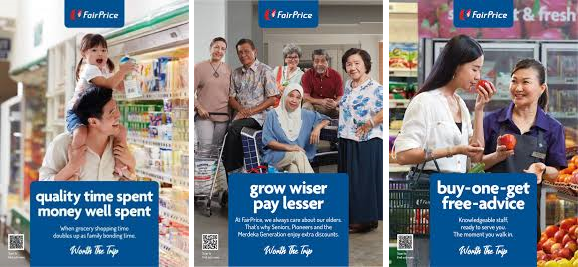Just like that, the first quarter of the year is almost over. Good news is – there’s still plenty of time to plan your next marketing campaign and continue driving demand for your product or service.
Successful campaigns have the power to drive emotions by telling stories that resonate with your audience and influence the behavior of your consumers. From how they engage with your brand to whether they would opt for your product or service.
As more and more marketing channels and technologies become available to marketers, the greater the reach and impact these campaigns could have on connecting with your audience.
To help save you time, we’ve got everything covered with our campaign playbook right here plus some real-life campaign examples that absolutely won hearts in Singapore in 2019.
“Meet me halfway” by SK-II
This beauty brand continues to celebrate today’s generation of Chinese women who are taking very different paths compared to their parents and grandparents. The film is part of SK-II’s broader #ChangeDestiny campaign that was launched in 2016, and continues to generate conversations.
What we can learn from SK-II:
In marketing, it is absolutely critical that we know our target persona – inside out – and that we tell stories that can truly connect with them. SK-II showed us an example of what it’s like to know your audience deeply, and to recognize their challenges and pain points. And be able to personalize your brand messaging to represent these pain points.
According to SK-II Global Marketing Director Kylene Campos,
“Brands may approach women empowerment campaigns as a one-off, resulting in efforts appearing inauthentic. This creates the impression that the problem is solved after just one campaign. The reality is the issue will not go away anytime soon.
For the past few years, SK-II has been committed to tackling the specific area of age and marriage pressure as we know this matters the most to our target consumer.”
“We are sorry” by IRVINS
Since we’re on the topic of winning hearts here – this next example is not your typical “campaign” but definitely worth a mention due to the company’s exceptional response to the crisis when someone posted on social media that there was a dead lizard in the snack pouch.
What we can learn from IRVINS:
The snack company immediately posted an explanation on their official Facebook page, and the post generated over 10K comments and 16K shares from people mostly complimenting the team’s response with words like “honest”, “sincere”, “responsible” and “professional”. Several of these comments were made by people who said they plan to purchase more IRVINS salted egg chips.
If we break down the company’s Facebook response, we can note the three main ingredients to their official apology post
- Acknowledgment of the incident
- Apology that was sincere and coming from the founder/owner himself
- Action to assure the public that the incident will not happen again and that affected customers have the option to get a refund
No one likes a crisis but sometimes, a crisis could serve as a great opportunity for a successful campaign if one acts fast and genuine.
Grab a copy of these crisis management templates and make sure you are ready in case a crisis hits.
“A World Without Telco Contracts” by Circles.Life
The digital telco operator launched in the Singapore market just over three years ago and has quickly earned the media’s attention with their controversial marketing campaigns across offline and online channels. The company has been consistent with their messaging telling consumers that they should break free from telco contracts.
What we can learn from Circles.Life:
As the country’s first virtual network operator, one of the biggest challenges Circles.Life had to face since launching is the fact that consumers do not really understand fully how digital telcos work. There was a lot of education that needed to be done. How did they tackle the challenge?
They leverage public relations to expand the reach of their campaigns. Circles.Life’s PR-first approach shows us the power of maximizing owned media as well as earned media in getting the attention of your target audience and boosting campaign performance.
According to Carrie Sim, Senior Marketing Manager at Circles.Life,
“When we brainstorm about our campaign, we always think of the headline first. Will this have a good enough hook for local media? How do we toe the line and still remain tongue-in-cheek?”
“Tiger district bottle” by Tiger Beer in partnership with Singapore Tourism Board
In this campaign, the beverage company was promoting their locally brewed beer with 20 Singapore-themed Tiger Beer bottles. Four out of 20 of the artworks came with hidden augmented reality (AR) features showcasing popular districts – Chinatown, Bugis, Katong and Tiong Bahru.
What we can learn from Tiger Beer & Singapore Tourism Board (STB):
As brands continue to compete for the audience’s bandwidth in this ever-connected world, experiential marketing plays an extremely important role for brands to create lasting impressions that consumers would love to share with their own networks. This, ultimately, leads to brand loyalty.
Your product is probably one of the best marketing tools that allows you to immerse consumers in these memorable experiences, and Tiger Beer did exactly that in this campaign with STB.
According to a statement from STB, the AR components “help consumers learn about the various offerings within the precinct, and be inspired to experience them in person”.
“Worth the trip” by NTUC Fairprice
Amidst the emergence of online delivery platforms, the supermarket company launched a campaign that was rooted on the insight that time spent grocery shopping is time well spent because it is an activity that is often done with family and friends.
Another great example of a brand that’s choosing to immerse consumers into live experiences.

Fairprice Worth The Trip campaign
What we can learn from NTUC Fairprice:
Marketers today are often facing challenges when it comes to choosing which media channels to focus on. However, this same challenge is in itself an opportunity for marketers to shift to an omnichannel approach for their marketing campaigns.
In this example from Fairprice, the company managed to use a combination of video content (film/online videos), in-store promotions, out-of-home advertising, and digital/social media platforms to reach consumers and drive them to almost 150 Fairprice stores nationwide.
Now that you have some inspirations to benchmark on - let’s dive into some questions to guide you in the right direction as you start planning your next marketing campaign:
- What is the purpose / objective of your marketing campaign?
- Who is your target audience?
- When do you plan to roll it out?
- How do you plan to reach your audience?
- What metrics should you monitor?
Grab this free marketing plan bundle to get started with your next campaign!



